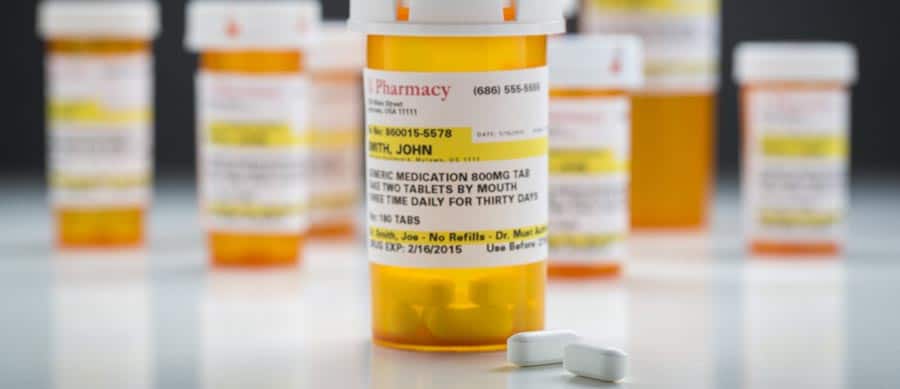Prescription opioids are some of the most commonly used drugs to treat pain. However, consistent misuse of these drugs continues to be an ongoing epidemic in the U.S. and elsewhere. More than 191 million opioid prescriptions were dispensed to Americans in 2017, and in 2018, about 9.9 million Americans over the age of 12 reported misusing prescription pain relievers in the past year.1,2 Not surprisingly, an estimated 1.7 million Americans were addicted to pain relievers and two million had an opioid use disorder in 2018.2
Table of contents
Prescription opioid pain relievers are frequently prescribed by doctors to treat pain, but that does not mean they are safe. Most opioid pain relievers are controlled substances that have a high potential for abuse. While they do work to relieve pain, they also produce feelings of euphoria, which can make it extremely difficult to stop using them, especially after taking them for an extended amount of time.
Depending on the type of prescription opioid taken, its side effects, risks, and potency will vary. Regardless of potency, all prescription opioids should be used with extreme caution and only as prescribed. Any misuse of these drugs can contribute to addiction, overdose, or death.
Here are some of the most common prescription opioid pain relievers, from strongest to weakest.
Opioid Pain Medication List: Strongest to Weakest
Carfentanil
Carfentanil is a highly potent synthetic opioid and a fentanyl analog. According to the U.S. Drug Enforcement Administration (DEA), carfentanil is about 10,000 times more potent than morphine and 100 times more potent than fentanyl.3 It is used as a tranquilizer for elephants and other large animals so even a very tiny dose can be lethal in humans. Carfentanil has been linked to a significant number of overdose deaths all over the country and continues to be a serious danger to public safety. Occasionally it is found on the black market and has surfaced in communities all over the U.S.
Sufentanil (Dsuvia)
Dsuvia is the most powerful opioid painkiller approved for human use. It is up to 10 times stronger than fentanyl and 1000 times more potent than morphine.4 Dsuvia was approved by the FDA in 2018 and was developed for acute pain management in a hospital setting. It is only available in medically supervised settings but many health experts have concerns about the drug’s potential for misuse, abuse, and diversion.
Fentanyl
Fentanyl is a synthetic opioid that was initially developed to treat patients suffering from cancer-related pain. When abused, it can produce temporary feelings of euphoria and a powerful, short-lived high. Due to its high potential for abuse, it is frequently found on the black market and illegally manufactured in secret labs, primarily located in Mexico. According to the DEA, fentanyl is 80 to 100 times stronger than morphine.5 Many illegal drug manufacturers add fentanyl to heroin to increase its potency, but most often, buyers are under the impression they are buying pure heroin. They don’t know they are buying or consuming fentanyl, which can lead to dangerous side effects or an accidental overdose.
Hydromorphone (Dilaudid)
Hydromorphone is another prescription pain reliever that is two to eight times more potent than morphine.6 It produces feelings of euphoria, relaxation, and sedation, and also works to relieve feelings of anxiety. It is classified as a Schedule II drug in the U.S. and is frequently used as a substitution for heroin because it can easily be dissolved with water and injected into the bloodstream to produce similar euphoric effects.
Oxymorphone (Opana)
Oxymorphone is a powerful prescription opioid pain reliever used to treat moderate to severe pain. It is a Schedule II drug and, much like others in its class, is highly addictive and can produce strong feelings of euphoria and relaxation. People who abuse oxymorphone often do so by consuming large doses orally, snorting it, or dissolving it and injecting it.7
Methadone (Methadose, Dolphine)
Methadone is a synthetic opioid and a Schedule II drug that comes in tablet, capsule, and liquid form. Although it is used as a prescription pain reliever, it is also often used as medication-assisted treatment during drug detox and treatment for opioid addiction. Methadone should only ever be used under the strict supervision of a doctor and any nonmedical use is illegal. Chemically speaking, methadone is different than morphine or heroin, but if it is abused, it can produce similar effects, making it a highly powerful and addictive drug.8
Oxycodone (Percocet, OxyContin)
Oxycodone is a semi-synthetic prescription opioid drug that is derived from the poppy plant. It is an extremely addictive drug that is popular among narcotic abusers. Most people who are addicted to opioids misuse oxycodone by crushing the tablets and snorting them or by dissolving them in water and injecting. Other people may place a tablet on a piece of foil, heat it, and inhale the vapors. Much like other opioids, when oxycodone is misused, it produces powerful feelings of euphoria, pain relief, and relaxation. Although oxycodone is less potent than the opioids listed above, it is still a Schedule II drug and has a high potential for dependence and addiction.9
Morphine
Morphine is an opiate that is naturally occurring in the opium poppy plant. While it is extremely effective for treating pain, it is also very addictive and has a high potential for abuse. It is classified as a Schedule II drug in America and is very similar in potency to oxycodone. Most people who abuse morphine prefer to inject it, as its effects can be felt almost instantaneously.10
Hydrocodone (Vicodin, Lortab)
Hydrocodone is prescribed to treat moderate pain. It is nearly as powerful as morphine and even though it is a less potent opioid, it is very highly abused. Hydrocodone is the most commonly prescribed opioid in America and it is frequently distributed and misused illegally.11 Most people who abuse hydrocodone get it by forging prescriptions, “doctor shopping,” stealing the drug, and some doctors and pharmacists even distribute it illegally. Users also frequently take hydrocodone with alcohol to enhance its effects. In many instances, people who are addicted to hydrocodone will eventually move on to using a more potent opioid as their tolerance increases.
Codeine
Codeine is a less potent opioid drug that is used to treat mild to moderate pain. It is also an ingredient in some prescription Tylenol medications that are used to treat coughing.12 Due to its weaker potency, codeine is much less likely than the other opioids on this list to be abused, but misuse of this drug does occur.
Meperidine (Demerol)
Meperidine is a synthetic opioid that is frequently used when other non-opioid pain treatments are ineffective.13 It is weaker than the other opioids on this list, however, it should be regarded as being just as dangerous because tolerance, dependence, and addiction can sometimes occur even faster than with the more powerful opioids listed above.
Tramadol (Ultram)
Tramadol is a commonly prescribed opioid pain medication, with 41 million tramadol prescriptions dispensed in 2017.14 It is very similar to meperidine, in terms of potency, but it is considered less dangerous because it is not as likely to cause physical dependency and addiction. Regardless, misusing tramadol for recreational purposes or taking larger or more frequent doses than prescribed can still lead to addiction.
Get Help for Opioid Addiction
Abusing prescription opioid painkillers is a slippery slope, regardless of how weak or powerful a drug may be. Whether your prescription drug abuse has gotten out of hand or you’ve moved on to abusing heroin, you should know that you’re not alone in this struggle. Many people find themselves in your shoes with no clue where to turn for help.
If you’re suffering from opioid addiction, the caring professionals at Briarwood Detox Center are here for you. You don’t have to resort to quitting cold turkey or trying The Thomas Recipe at home. We offer personalized opioid detox programs to help you overcome your physical dependence on opioids and start working toward a new life in recovery. Call (888) 857-0557 to learn more about our drug and alcohol detox programs today.
References:
- https://www.samhsa.gov/data/sites/default/files/cbhsq-reports/NSDUHNationalFindingsReport2018/NSDUHNationalFindingsReport2018.pdf
- https://www.dea.gov/press-releases/2016/09/22/dea-issues-carfentanil-warning-police-and-public
- https://abcnews.go.com/Health/dsuvia-opioid-painkiller/story?id=58875487
- https://www.dea.gov/factsheets/fentanyl
- https://www.dea.gov/factsheets/hydromorphone
- https://www.deadiversion.usdoj.gov/drug_chem_info/oxymorphone.pdf
- https://www.dea.gov/factsheets/methadone
- https://www.dea.gov/sites/default/files/sites/getsmartaboutdrugs.com/files/publications/DoA_2017Ed_Updated_6.16.17.pdf#page=47
- https://www.dea.gov/sites/default/files/sites/getsmartaboutdrugs.com/files/publications/DoA_2017Ed_Updated_6.16.17.pdf#page=45
- https://www.deadiversion.usdoj.gov/drug_chem_info/hydrocodone.pdf
- https://medlineplus.gov/druginfo/meds/a682065.html
- https://www.drugs.com/demerol.html
- https://www.deadiversion.usdoj.gov/drug_chem_info/tramadol.pdf


